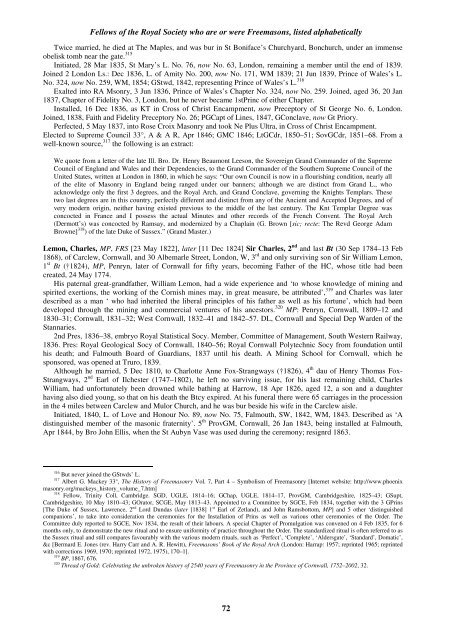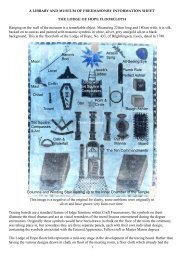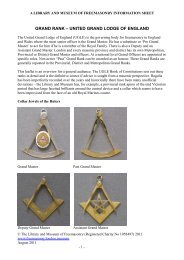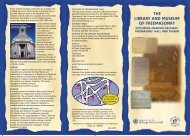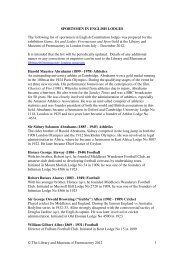FREEMASONS AND THE ROYAL SOCIETY Alphabetical List of ...
FREEMASONS AND THE ROYAL SOCIETY Alphabetical List of ...
FREEMASONS AND THE ROYAL SOCIETY Alphabetical List of ...
Create successful ePaper yourself
Turn your PDF publications into a flip-book with our unique Google optimized e-Paper software.
Fellows <strong>of</strong> the Royal Society who are or were Freemasons, listed alphabetically<br />
Twice married, he died at The Maples, and was bur in St Boniface’s Churchyard, Bonchurch, under an immense<br />
obelisk tomb near the gate. 315<br />
Initiated, 28 Mar 1835, St Mary’s L. No. 76, now No. 63, London, remaining a member until the end <strong>of</strong> 1839.<br />
Joined 2 London Ls.: Dec 1836, L. <strong>of</strong> Amity No. 200, now No. 171, WM 1839; 21 Jun 1839, Prince <strong>of</strong> Wales’s L.<br />
No. 324, now No. 259, WM, 1854; GStwd, 1842, representing Prince <strong>of</strong> Wales’s L. 316<br />
Exalted into RA Msonry, 3 Jun 1836, Prince <strong>of</strong> Wales’s Chapter No. 324, now No. 259. Joined, aged 36, 20 Jan<br />
1837, Chapter <strong>of</strong> Fidelity No. 3, London, but he never became 1stPrinc <strong>of</strong> either Chapter.<br />
Installed, 16 Dec 1836, as KT in Cross <strong>of</strong> Christ Encampment, now Preceptory <strong>of</strong> St George No. 6, London.<br />
Joined, 1838, Faith and Fidelity Preceptory No. 26; PGCapt <strong>of</strong> Lines, 1847, GConclave, now Gt Priory.<br />
Perfected, 5 May 1837, into Rose Croix Masonry and took Ne Plus Ultra, in Cross <strong>of</strong> Christ Encampment.<br />
Elected to Supreme Council 33°, A & A R, Apr 1846; GMC 1846; LtGCdr, 1850–51; SovGCdr, 1851–68. From a<br />
well-known source, 317 the following is an extract:<br />
We quote from a letter <strong>of</strong> the late Ill. Bro. Dr. Henry Beaumont Leeson, the Sovereign Grand Commander <strong>of</strong> the Supreme<br />
Council <strong>of</strong> England and Wales and their Dependencies, to the Grand Commander <strong>of</strong> the Southern Supreme Council <strong>of</strong> the<br />
United States, written at London in 1860, in which he says: “Our own Council is now in a flourishing condition, nearly all<br />
<strong>of</strong> the elite <strong>of</strong> Masonry in England being ranged under our banners; although we are distinct from Grand L., who<br />
acknowledge only the first 3 degrees, and the Royal Arch, and Grand Conclave, governing the Knights Templars. These<br />
two last degrees are in this country, perfectly different and distinct from any <strong>of</strong> the Ancient and Accepted Degrees, and <strong>of</strong><br />
very modern origin, neither having existed previous to the middle <strong>of</strong> the last century. The Knt Templar Degree was<br />
concocted in France and I possess the actual Minutes and other records <strong>of</strong> the French Convent. The Royal Arch<br />
(Dermott’s) was concocted by Ramsay, and modernized by a Chaplain (G. Brown [sic; recte: The Revd George Adam<br />
Browne] 318 ) <strong>of</strong> the late Duke <strong>of</strong> Sussex.” (Grand Master.)<br />
Lemon, Charles, MP, FRS [23 May 1822], later [11 Dec 1824] Sir Charles, 2 nd and last Bt (30 Sep 1784–13 Feb<br />
1868), <strong>of</strong> Carclew, Cornwall, and 30 Albemarle Street, London, W, 3 rd and only surviving son <strong>of</strong> Sir William Lemon,<br />
1 st Bt (†1824), MP, Penryn, later <strong>of</strong> Cornwall for fifty years, becoming Father <strong>of</strong> the HC, whose title had been<br />
created, 24 May 1774.<br />
His paternal great-grandfather, William Lemon, had a wide experience and ‘to whose knowledge <strong>of</strong> mining and<br />
spirited exertions, the working <strong>of</strong> the Cornish mines may, in great measure, be attributed’, 319 and Charles was later<br />
described as a man ‘ who had inherited the liberal principles <strong>of</strong> his father as well as his fortune’, which had been<br />
developed through the mining and commercial ventures <strong>of</strong> his ancestors. 320 MP: Penryn, Cornwall, 1809–12 and<br />
1830–31; Cornwall, 1831–32; West Cornwall, 1832–41 and 1842–57. DL, Cornwall and Special Dep Warden <strong>of</strong> the<br />
Stannaries.<br />
2nd Pres, 1836–38, embryo Royal Statistical Socy. Member, Committee <strong>of</strong> Management, South Western Railway,<br />
1836. Pres: Royal Geological Socy <strong>of</strong> Cornwall, 1840–56; Royal Cornwall Polytechnic Socy from foundation until<br />
his death; and Falmouth Board <strong>of</strong> Guardians, 1837 until his death. A Mining School for Cornwall, which he<br />
sponsored, was opened at Truro, 1839.<br />
Although he married, 5 Dec 1810, to Charlotte Anne Fox-Strangways (†1826), 4 th dau <strong>of</strong> Henry Thomas Fox-<br />
Strangways, 2 nd Earl <strong>of</strong> Ilchester (1747–1802), he left no surviving issue, for his last remaining child, Charles<br />
William, had unfortunately been drowned while bathing at Harrow, 18 Apr 1826, aged 12, a son and a daughter<br />
having also died young, so that on his death the Btcy expired. At his funeral there were 65 carriages in the procession<br />
in the 4 miles between Carclew and Mulor Church, and he was bur beside his wife in the Carclew aisle.<br />
Initiated, 1840, L. <strong>of</strong> Love and Honour No. 89, now No. 75, Falmouth, SW, 1842, WM, 1843. Described as ‘A<br />
distinguished member <strong>of</strong> the masonic fraternity’. 5 th ProvGM, Cornwall, 26 Jan 1843, being installed at Falmouth,<br />
Apr 1844, by Bro John Ellis, when the St Aubyn Vase was used during the ceremony; resignrd 1863.<br />
316<br />
But never joined the GStwds’ L.<br />
317<br />
Albert G. Mackey 33°, The History <strong>of</strong> Freemasonry Vol. 7, Part 4 – Symbolism <strong>of</strong> Freemasonry [Internet website: http://www.phoenix<br />
masonry.org/mackeys_history_volume_7.htm]<br />
318<br />
Fellow, Trinity Coll, Cambridge. SGD, UGLE, 1814–16; GChap, UGLE, 1814–17, ProvGM, Cambridgeshire, 1825–43; GSupt,<br />
Cambridgeshire, 10 May 1810–43; GOrator, SCGE, May 1813–43. Appointed to a Committee by SGCE, Feb 1834, together with the 3 GPrins<br />
[The Duke <strong>of</strong> Sussex, Lawrence, 2 nd Lord Dundas (later [1838] 1 st Earl <strong>of</strong> Zetland), and John Ramsbottom, MP] and 5 other ‘distinguished<br />
companions’, to take into consideration the ceremonies for the Installation <strong>of</strong> Prins as well as various other ceremonies <strong>of</strong> the Order. The<br />
Committee duly reported to SGCE, Nov 1834, the result <strong>of</strong> their labours. A special Chapter <strong>of</strong> Promulgation was convened on 4 Feb 1835, for 6<br />
months only, to demonstrate the new ritual and to ensure uniformity <strong>of</strong> practice throughout the Order. The standardized ritual is <strong>of</strong>ten referred to as<br />
the Sussex ritual and still compares favourably with the various modern rituals, such as ‘Perfect’, ‘Complete’, ‘Aldersgate’, ‘Standard’, Domatic’,<br />
&c [Bermard E. Jones (rev. Harry Carr and A. R. Hewitt), Freemasons’ Book <strong>of</strong> the Royal Arch (London: Harrap: 1957; reprinted 1965; reprinted<br />
with corrections 1969, 1970; reprinted 1972, 1975), 170–1].<br />
319<br />
BP, 1867, 676.<br />
320<br />
Thread <strong>of</strong> Gold: Celebrating the unbroken history <strong>of</strong> 2540 years <strong>of</strong> Freemasonry in the Province <strong>of</strong> Cornwall, 1752–2002, 32.<br />
72


